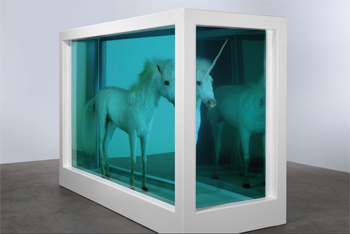
IN THE FRAY
Hirst's Marketing End RunBy MELIK KAYLAN | August 23, 2008; Page W12
Much hubbub has attended Damien Hirst's decision to sell his art directly via Sotheby's auction house in mid-September without going through his big-name gallerists, Larry Gagosian and Jay Joplin. Some have seen this direct-to-market ploy by the artist as more evidence of his titanic Duchampian originality, as if even the way he plans to sell his work is a radical new art form. According to the Web site Art Observed, Sotheby's spokesman Oliver Barker has offered his perspective that "Damien is totally fearless. He's not just an outstanding artist; he's a cultural phenomenon."
Damien Hirst One might forgive Sotheby's its enthusiasm. The estimates for the total value of the coming London sale range from $100 million to $200 million. Unbelievers and obstinate refuseniks, however, view the entire episode as hype piled upon more hype around a ghoulish publicity-monger. The sale includes several more of Mr. Hirst's trademark pickled animal carcasses, such as a shark, a zebra and -- the centerpiece offering -- a cow with golden horns and hoofs (expected to fetch some $25 million).
Increasingly lost amid the noise is this question: What does it mean for the art market that a living artist bypasses dealers altogether and sells his wares directly at auction? There is some speculation that this might be a pivotal moment, like the end of the studio system in movies or the continuing decline of the record labels in the music business. Could the gallerist's traditional role as mediator between the contemporary artist and his market be passé?
Most insiders say that only at the topmost end of the market, where sales at auction are guaranteed by the artist's fame, could the middleman become an anachronism -- and that just a handful of artists, such as Damien Hirst and Jeff Koons, have the kind of fame it takes. Dealers still have a crucial role to play, the argument goes, in building the reputation of artists; in finding the right -- influential -- homes for artists' works; in persuading museums of artists' worth; in taking reviewers out to lunch. Furthermore, it is noted, the art biz differs from show biz in a fundamental way: Movies and music sell to a mass audience, while art sells singly to individuals.
That is where, for now, the debate seems to have stalled, at the consensus that nothing much will change. A comforting thought, perhaps, but one that falls apart at the slightest prodding. It's certainly comforting that the most imperiled are the top-end headhunters, like Mr. Gagosian, who encouraged the cult of celebrity to supplant content and aesthetics as the foremost value in art. But beyond that, one wonders how it will affect the role of galleries when ultimate success automatically carries a built-in penalty: If they create a big enough star, the star will have no need of them. At the very least, dealers and gallerists in contemporary art will face a solid ceiling beyond which they cannot maximize profit on the investment they made nurturing artists. They simply cannot compete with the global footprint of international auction houses, which offer artists instant access to world-wide markets.
In reality, the art biz is more like the movie or music biz than one might think. Mass markets, like mass media, affect the thinking of visual artists all too palpably these days, however uniquely each of their pieces may be made and sold.
As Russian, Chinese and Arab buyers enter the ultraspeculative end of the contemporary market, in which nobody knows why Hirst's dead cow is worth more than Koons's ceramic monkey, dealers will find themselves at a disadvantage to auction houses in other ways, too.
Because Sotheby's and Christie's appear to operate a species of global commodities exchange, with dates and prices instantly disclosed on the Internet, it all feels so much more transparent to, say, a new Chinese millionaire. In the first place, there will be a local office near him co-headed by a Chinese speaker who understands the millionaire's social sensitivities -- so much more pleasant than having to kow-tow to a self-important New York or London gallerist. It puts an end to a long era in which superior dealers could treat outsider clients with the snooty hauteur of a French waiter. Above all, though, the auction houses' relative transparency -- the fact that prices are set and transactions occur out in the open, for all to see -- will appeal to the international new money crowd that knows plenty about how money and markets work.
Dealers have always offered clients a higher degree of discretion than the public space of an auction ever can. That has traditionally been their great asset. But let's be candid: Nobody in Dubai or Shanghai wants a pickled cow to gaze at musingly in solitude for the sheer beauty of its hindquarters. When today's clients buy such wares, privacy is the last thing on their minds. They are buying into celebrity. As Thomas Hoving, the former director of the Metropolitan Museum, once said: "Social climbing and art have gone together since Alexander brought Lysippas to his court, and before."
As the market's top end begins to evaporate for them, contemporary dealers should reconsider the Duchamp-Warhol ethos of shock and celebrity that has come to dominate the art world. Perhaps it is time for dealers to start embracing what will save them: art valued on its merits without the hype.
Mr. Kaylan writes about the arts and culture for the Journal.
 IN THE FRAY
IN THE FRAY